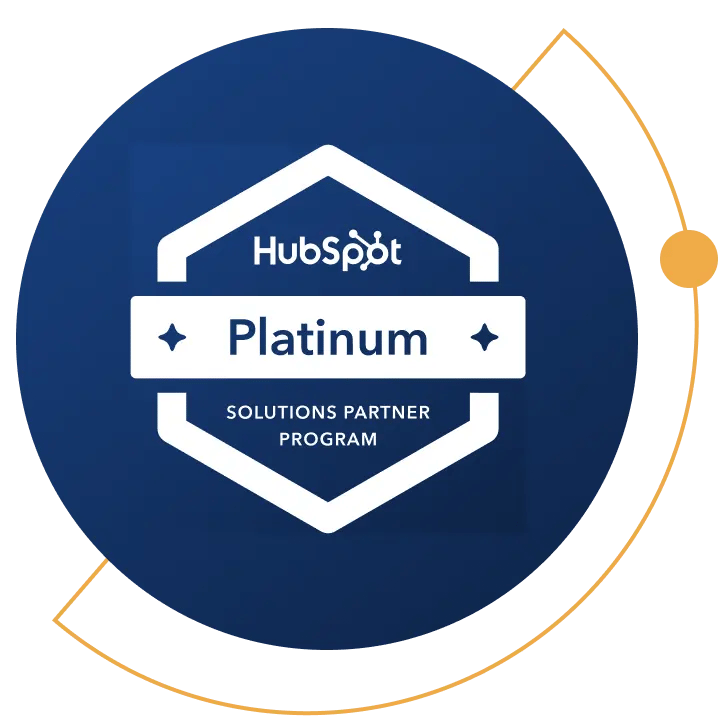HubSpot AI Customer Agent Guide: Train, Launch, and Scale B2B Support
AI is no longer just helping us do tasks faster—it’s removing them from our plates entirely. Imagine never having to answer the same customer question twice. Businesses have moved beyond simply using AI to letting it handle entire interactions, conversations, and relationships seamlessly. At the forefront of this shift are AI Customer Agents: intelligent tools trained specifically on your business’s content and context, delivering personalized customer support around the clock.
Think about it this way: Instead of manually responding to repetitive inquiries about your shipping policies or pricing, your AI agent instantly serves accurate, customized responses. You barely lifted a finger, yet your customer got exactly what they needed.
That’s the power of HubSpot’s new AI Customer Agent—an innovative addition to your team designed to handle customer interactions effortlessly and at scale. Here’s what you need to know.
Understanding HubSpot’s Customer Agent
HubSpot’s AI Customer Agent is an intelligent virtual assistant designed to seamlessly handle customer inquiries through personalized, real-time conversations. Integrated directly within HubSpot's Service Hub, this powerful tool leverages advanced AI—specifically large language models (LLMs) like ChatGPT—to provide instant, accurate responses tailored uniquely to your business.
In this short clip, you'll quickly learn how HubSpot’s AI Customer Agent works, explained clearly and directly:
Originally launched to support businesses managing high volumes of customer tickets—such as ecommerce brands—the Customer Agent has quickly proven valuable across industries. It goes beyond typical AI chatbots by allowing you to train it with your own content, including knowledge base articles, product details, FAQs, and even pricing specifics. As a result, your customers receive genuinely helpful, contextually relevant interactions.
Put simply: it's your customer service team’s new best friend—always available, infinitely scalable, and customized precisely to your business needs.
HubSpot’s Customer Agent offers three primary configuration options—Customer Support, Marketing Specialist, and Sales Representative. At Vaulted, we've found the Customer Support configuration to deliver the most immediate impact and strongest results, particularly for clients looking to automate repetitive support tasks and elevate customer satisfaction.
Now that you know what HubSpot’s Customer Agent is and why we lean on the Customer Support configuration, let’s look at the real-world gains teams see once it’s live.
Benefits of Using HubSpot’s Customer Agent
When Vaulted deploys an AI Customer Agent, three expanded benefits surface time and again—each delivering measurable impact without the overhead of new hires.
1. Expanded Customer Support
A well-trained agent works 24/7, covering nights, weekends, and holidays for a fraction of the cost of after-hours staff. At Mon Kit Solaire, setup took around two hours yet immediately freed employees from routine chats, letting them focus on appointments, phone calls, and complex email requests—proof that rapid deployment can translate directly into cost savings and better service.
B. Efficiency + Consistency
By deflecting repetitive inquiries and generating on-brand answers in seconds, the agent slashes queue lengths while keeping every response aligned with approved messaging.

Kaplan Early Learning’s administrator reports that their agent now resolves 37% of the company’s chat requests without human intervention, accelerating ticket resolution times and giving human reps bandwidth for nuanced cases.
C. Actionable Insights
Every conversation the AI handles is logged in HubSpot, exposing content gaps, emerging pain points, and product-specific confusion you might otherwise miss. These transcripts create a living feedback loop—fuel for updating knowledge articles, refining workflows, and guiding product teams toward high-impact fixes—so your support operation continually improves alongside customer needs.
Ready to see those gains in action? Let’s look at how to get your own Customer Agent trained, tuned, and deployed inside HubSpot in three straightforward steps.
Setting Up the Customer Agent
Before an AI teammate can solve customer issues on your behalf, you need to train it, tune it, and give it and assignment:
1. Training Your Customer Agent
Training your customer agent means equipping it with the content that defines how your business solves problems and communicates with customers. Below are three critical content areas we most often see leveraged on the customer-success side:
- Knowledge Base and FAQ Articles: Supplying the agent with these resources lets it tackle routine troubleshooting questions and common “How do I do...?” inquiries without human intervention.
- Product and Feature Pages: Detailed product specifications, features, pricing, warranties, and return guidelines ensure every answer the agent gives aligns with current customer success operations.
- Internal Documents: Standard operating procedures, playbooks, onboarding checklists, or even a PDF of your support team’s escalation matrix teach the agent your exact workflows and preferred language for complex scenarios, so its responses mirror your team’s own guidance.
You’re not limited to content that already lives inside HubSpot; the platform can ingest externally hosted pages or even standalone files—such as a PDF of your customer success playbook. Curating this mix of internal, external, and file-based material shapes the agent into a brand-aligned, context-aware resource that delivers salient, relevant answers every time a customer reaches out.
2. Configuring Your Agent
After training comes fine-tuning: this is where you shape the AI’s tone and set the guardrails that tell it when to step aside for a human. HubSpot’s configuration panel makes the process straightforward, but two settings deserve extra attention. First is Personality, where we recommend selecting Brand Voice.

This option applies the same stylistic rules you’ve defined elsewhere in HubSpot—word choice, formality, even sentence length—so every AI response sounds like it was written by your team, not a generic bot. Consistent voice builds trust and keeps the customer experience seamless across chat, email, and every other channel you run through HubSpot.
Equally important are the Hand-Off Settings. Here you specify the phrases—“talk to a person,” “human help,” “agent please,” and so on—that instantly transfer a conversation to a live rep. Clear triggers prevent the AI from fumbling complex, sensitive, or high-value issues, ensuring customers never feel trapped in an endless loop of automated replies. In practice, a well-configured hand-off policy maintains efficiency for simple queries while safeguarding the human touch that’s still essential for nuanced support.
3. Assigning the Agent to Channels
With training complete and settings dialed in, the final step is deciding where your Customer Agent will interact with customers. HubSpot lets you attach the agent to multiple service channels so you can start small, measure the impact, and gradually expand to the areas that deliver the greatest relief for your support team.
| Channel | Channel Description | Why It Matters |
|---|---|---|
| Live Chat | Real-time messaging widget on your website. | Deflects repetitive questions instantly, providing an easy proving ground for AI-powered support. |
| Inbox | Shared email queue inside HubSpot. | Automates first-response emails and sorts messages by complexity, easing backlogs for human reps. |
| Help Desk | Ticketing interface for logged customer issues. | Suggests solutions before a ticket hits the queue, reducing volume and accelerating resolution times. |
Start with one channel, observe performance, and iterate. This experimental approach helps you pinpoint where the Customer Agent adds the most value—then scale those wins across the rest of your support stack.
Ideal Use Cases & Scenarios: Where the AI Customer Agent Shines in B2B Customer Support
Not every B2B organization needs an AI Customer Agent—but when you’re selling complex solutions that demand ongoing support, it can be transformative. Think enterprise software with tier‑2 troubleshooting, capital equipment that runs 24/7 on a factory floor, or professional services engagements where clients expect white‑glove communication. In these settings, customers aren’t hunting discounts; they want fast, expert guidance that keeps their mission‑critical operations on track. A HubSpot Customer Agent meets that need by living on your site (or in your inbox, chat, or help desk)—delivering technical answers in seconds and escalating to humans only when deeper expertise is required.
Industry Snapshots
Below are four B2B support scenarios where the AI Customer Agent consistently turns technical questions into satisfied users—and frees human reps for high‑value problem‑solving.
B2B SaaS & Enterprise Software
A manufacturing firm rolls out a $25 K/year ERP platform. At 10 p.m., a line‑of‑business manager can’t sync production data, while the finance team wants clarification on audit logs. The AI Customer Agent surfaces the exact integration guide, links a video walkthrough, and supplies a compliance article—logging the entire exchange to HubSpot. By morning, support sees a resolved ticket and a detailed transcript, with no human time spent on after‑hours triage.
Manufacturing & Industrial Equipment
A plant operator needs torque specs and maintenance intervals for a $180 K CNC machine that just threw an error code. The agent—trained on service manuals and parts catalogs—delivers the spec, displays a step‑by‑step diagnostic, and offers a PDF parts list. It also captures the machine’s serial number and schedules a preventive‑maintenance reminder, so technicians arrive prepared instead of scrambling for basics.
Professional Services & Consulting
A new retainer client wants to check project milestones and billing details outside office hours. The AI agent pulls timeline data from the project tracker, explains the next deliverable, and confirms the upcoming invoice schedule. Routine status pings no longer interrupt senior consultants, who can focus on strategy calls instead of “Where’s my report?” emails.
Technical Training & Certification Providers
A cohort of IT professionals starts a multi‑team cybersecurity certification. Learners hit the chat at odd hours with pass‑rate concerns, exam‑prep tips, and LMS login questions. The agent serves up pass‑rate stats, links SCORM‑compatible study guides, resets credentials, and logs common blockers. The training team now has data to improve course material while spending its time on custom workshops instead of password resets.
These support‑focused wins all stem from the same playbook: load the AI with authoritative content, let it handle the repetitive questions, and escalate only when a human can add real value. Next, we’ll dive into our favorite tips and best practices to train, test, and continually refine your Customer Agent so it stays sharp long after launch.
Our Favorite Tips for Using the Customer Agent
Rolling out HubSpot’s AI Customer Agent is less about flipping a switch and more about iterating in small, high-impact cycles. Below are four detailed practices we lean on when helping B2B clients launch and refine their agents.
1. Train — and Preview — Before You Go Live
Sync the knowledge base, spec sheets, internal playbooks, and any deal-shaping collateral into the agent’s content library. Then open the Preview panel (top-right of the setup screen) and pepper the bot with your toughest “day one” questions.
.png?width=2400&height=1347&name=preview-and-test-customer-agent-hubspot-vaulted%20(1).png)
Watch how a single added PDF or deleted page instantly changes the response quality. Repeat until answers read like a seasoned support rep—only then assign the agent to a live channel.
2. Curate Content That Answers Real Questions
Start with the issues customers actually raise in tickets or sales calls. A post about last quarter’s promo won’t help someone debug an integration. If you notice the bot serving vague or off-topic snippets, trace them back to the source and pull that page from the training set. Tighter corpus = tighter answers.
3. Set Up Brand Voice for a Consistent Tone
During configuration you can choose up to four personality traits (e.g., Professional, Friendly, Empathetic, Informative). It’s not surgical control, but it does nudge formality, phrasing, and vocabulary so the agent sounds like the rest of your brand. Pair those traits with a short style-guide excerpt—preferred terms, banned jargon, and reading-level targets—for extra guardrails.
4. Use Short Answers and Custom Files for Pin-Point Guidance
Content Hub automatically feeds the agent every live page and file, but high-stakes questions often need sharper direction:
- Short Answers: Drop in concise, authoritative snippets that settle edge-case queries (“What’s your SLA for Tier-2 outages?”).
- Custom Files: Create a Word doc or PDF that spells out escalation matrices, discount rules, or any internal SOP. Upload it, toggle it on, and the agent can reference those specifics instantly—no developer required.
An AI Customer Agent can’t invent expertise—it can only reflect what you give it. The tighter your content aligns with real-world support workflows, the sharper its answers and the faster it drives measurable impact. In other words, specificity equals success. When you load it with the same playbooks your best reps rely on, the agent responds like your best rep—only faster and around the clock.
Bringing It All Together
A finely tuned Customer Agent builds trust day and night with instant, expert answers, frees your specialists to tackle strategic work instead of fundamentals, and speeds qualified, context-rich leads into the sales pipeline—shortening cycles and boosting win rates.
Ready to put an always-on Customer Agent to work for your B2B growth goals?
Book a brief discovery call with Vaulted’s HubSpot team, and we’ll show you how quickly tailored training, smart configuration, and measured rollout can translate into real revenue impact.

Launch Your 24/7 AI Support Engine
As a HubSpot Platinum Solutions Partner, Vaulted can train, test, and deploy your Customer Agent—deflecting routine tickets and boosting CSAT in weeks, not months.
Frequently Asked Questions
1. How long does it take to get a Customer Agent live?
Implementation timelines vary by complexity. For large enterprises with sprawling product lines and strict QA requirements, a staged rollout—content audit, sandbox testing, and live-channel pilots—can take several months. Smaller teams with a focused knowledge base and clear hand-off rules often stand up a fully functioning agent in just a few weeks.
2. Will the agent replace my support staff?
No. The agent handles repetitive, well-documented questions so your human experts can concentrate on the nuanced, relationship-driven issues only people can solve—advanced troubleshooting, strategic upsells, and empathetic conversations. Instead of “replacing” staff, the agent amplifies their value by clearing away routine work and giving them more time for high-impact customer interactions.
3. What content should we feed the agent first
Think of your Customer Agent as a new hire: the clearer and more relevant the training material, the faster it becomes productive. Start by mapping your most common tickets and pre‑sales questions, then load the AI with sources that already answer those issues. We recommend this five‑part foundation:
-
Knowledge‑base articles – These are your frontline “how‑to” guides (password resets, integration steps, troubleshooting checklists). They give the agent authoritative, step‑by‑step solutions it can surface in seconds.
-
Problem‑solving blog posts – Evergreen posts that walk users through common pain points—“How to debug API errors in under five minutes,” for example—add depth and conversational context the KB may lack.
-
Internal policy and procedure docs – SLAs, warranty terms, escalation rules, and refund policies ensure the agent’s answers stay consistent with contractual obligations and won’t over‑promise.
-
Pricing and feature sheets – Up‑to‑date SKU matrices, tier comparisons, and add‑on descriptions let the agent handle cost, compatibility, and upsell questions accurately.
-
How‑to videos or annotated screenshots – Visual assets (embedded or linked) help users who prefer to follow along on screen, reducing back‑and‑forth and boosting first‑contact resolution.
This targeted mix mirrors the content your human reps already trust, giving the AI enough depth to sound like a seasoned teammate from day one—and plenty of room to expand as new questions surface in the Top Knowledge Gaps report.
4. How secure is customer data in an AI chat?
HubSpot layers several safeguards that align with SOC 2 Type II and GDPR standards. Data stays inside your portal; it isn’t used to train public models. When HubSpot must pass prompts to third‑party LLM providers, those vendors operate under a Zero Retention Data Policy, meaning prompts are deleted immediately after processing whenever technically feasible . A real‑time moderation layer blocks harmful content, and you can disable AI features or opt out of internal model training at any time . Vaulted recommends reviewing these controls during implementation and adding your own role‑based permissions audit for extra assurance.
5. How accurate is Brand voice control?
HubSpot offers 23 single‑word personality traits—from Professional and Scientific to Friendly and Playful. You can combine up to four of these traits to steer the agent’s tone, formality, and vocabulary. Think of them as directional guardrails: “Professional + Informative + Serious” yields concise, textbook‑style replies, while “Friendly + Empathetic + Playful” produces warmer, more conversational language. Helpful, yes—but remember these are broad strokes, not a full‑blown style guide. If you need absolute consistency with industry jargon or legal language, the trait sliders alone won’t get you there.
That’s where Short Answers and Custom Files close the gap. Short Answers let you hard‑code specific sentences or paragraphs the agent should reuse verbatim for critical questions (“Our standard SLA guarantees 99.9 % uptime”). Custom Files—Word docs or PDFs you upload—can house long‑form policy text, product comparison grids, or a full brand style manual. Because the Customer Agent indexes these files like any other source, you can embed precise phrasing and deeper context, ensuring compliance and on‑brand messaging even in edge‑case scenarios. Combined with your chosen Personality traits, these granular tools transform a rough stylistic nudge into pinpoint accuracy—down to the last comma.
6. Can we tune performance of Customer Agent after launch?
There are several ways to gather performance data and user feedback, but two go‑to options give you quick, actionable insight:
-
Top Knowledge Gaps – HubSpot automatically surfaces queries the agent couldn’t answer or answered with low confidence. Review this list weekly to identify missing articles, unclear wording, or topics that need deeper coverage, then update your training corpus or add Short Answers and Custom Files to close the gap.
-
Visitor Ratings & Transcripts – Users can mark individual answers as helpful or not. Drill into the “thumbs‑down” conversations to see exactly where the dialogue stalled or veered off‑topic. These qualitative clues help you refine Brand Voice phrasing, expand content, or tweak hand‑off triggers so similar issues are handled smoothly next time.
Tapping both data streams—quantitative gaps and qualitative ratings—creates a continuous improvement loop that steadily lifts accuracy, CSAT, and first‑contact resolution.
7. How can we prove the value of an AI Customer Agent?
Begin by capturing a pre‑launch baseline for ticket volume, first‑response time, resolution time, and CSAT. Then track the same figures at 30‑, 60‑, and 90‑day intervals. Improvements in these service‑efficiency metrics provide clear, quantifiable proof that the agent is doing its job:
-
Conversation volume vs. human hand‑offs – A growing share of chats resolved without escalation shows the agent is absorbing frontline work.
-
Average first‑response time – Instant AI replies should drop this number from minutes to seconds, demonstrating faster engagement.
-
Average resolution time – When the agent handles routine issues end‑to‑end, overall time‑to‑resolution shrinks, easing queue backlogs.
-
Rep hours saved – Multiply deflected tickets by your average handle time to quantify labor reclaimed for complex cases.
-
Customer sentiment (thumbs‑up / thumbs‑down + CSAT scores) – A lift in satisfaction confirms that speed isn’t coming at the cost of answer quality.
Display these metrics in a HubSpot dashboard so stakeholders can watch efficiency gains accrue in real time—no revenue modeling required.
Explore AI in HubSpot
Search by Tags
Be the First to
Know Subscribe to Our Newsletter!
Discover More Insights

Using HubSpot Like a Flip Phone? A Development Agency Can Fix That
. You know that feeling when you buy a fancy new phone, but all you use it for is texting and the occasional phone call? That’s what it’s like for some businesses using HubSpot. They invest in the platform packed with powerful tools and end up using just a sliver of what it can actually do. They sign up, poke around a bit, maybe send a newsletter or two, but never really unlock its full potential.

Search Engine Optimization Durham: Unlocking Organic Growth for Your Business
If you’ve ever watched another box truck lose its roof to Durham’s infamous “Can Opener” bridge, you know one thing: a small miscalculation can cost you big. The same goes for modern search engine optimization—especially now that AI results and GEO surfaces can shear off the traffic you once took for granted.

 Emily Davidson
Emily Davidson

 Jordan Parker
Jordan Parker